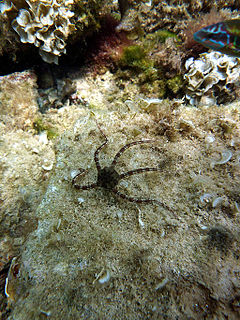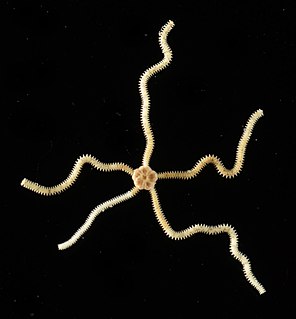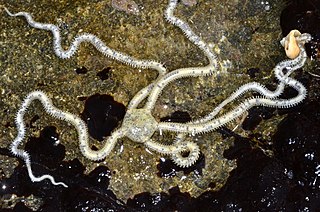| Ophiopholis | |
|---|---|
 | |
| Scientific classification | |
| Kingdom: | |
| Phylum: | |
| Class: | |
| Order: | |
| Family: | |
| Genus: | Ophiopholis |
| Species | |
see text. | |
Ophiopholis is a genus of brittle stars (Ophiuroidea) found in oceans worldwide from tropics to temperate regions.
| Ophiopholis | |
|---|---|
 | |
| Scientific classification | |
| Kingdom: | |
| Phylum: | |
| Class: | |
| Order: | |
| Family: | |
| Genus: | Ophiopholis |
| Species | |
see text. | |
Ophiopholis is a genus of brittle stars (Ophiuroidea) found in oceans worldwide from tropics to temperate regions.
The following species are recognised by the World Register of Marine Species : [1]

Brittle stars, serpent stars, or ophiuroids are echinoderms in the class Ophiuroidea closely related to starfish. They crawl across the sea floor using their flexible arms for locomotion. The ophiuroids generally have five long, slender, whip-like arms which may reach up to 60 cm (24 in) in length on the largest specimens. From New Latin ophiurus, from Ancient Greek ὄφις + οὐρά.

The giant basket star, Astrophyton muricatum, is an echinoderm found in shallow parts of the tropical western Atlantic and throughout the Caribbean Sea and the Gulf of Mexico. It is the only species in the genus Astrophyton. During the day, it curls up into a tight ball shape to protect itself from predators. At night, it climbs to an elevated point to feed by extending its intricately branched feeding arms in a bowl-like shape in order to snare passing plankton and other organisms from the current.

Ophiactidae are a family of brittle stars.

Ophiotrichidae are a family of ophiurid brittle stars within the infraorder Gnathophiurina.

Gorgonocephalus is a genus of marine basket stars in the class Ophiuroidea. Members of this genus are found in coldwater environments including the Arctic, the Antarctic, and deep-sea habitats. The scientific name comes from the Greek, gorgós meaning "dreaded" and -cephalus meaning "head", and refers to the similarity between these echinoids and the Gorgon's head from Greek myth with its coiled serpents for hair. The Greek mythological hero Perseus beheaded the Gorgon Medusa; when Perseus later dropped Medusa's head on the beach, her petrifying glance turned the nearby seaweed to stone, creating the first coral.

Ophioderma is a genus of brittle stars in the family Ophiodermatiidae.

Amphiodia pulchella is a species of brittle star belonging to the family Amphiuridae. It is found in the Caribbean Sea and the Gulf of Mexico.

Ophiocoma is a genus of brittle stars belonging to the family Ophiocomidae.
Nudamphiura is a genus of echinoderms. Nudamphiura was described by Luiz Roberto Tommasi in 1965.

Astroboa is a genus of basket stars in the class Ophiuroidea.
Ophiozonella depressa is a species of brittle stars from the family Ophiolepididae. The brittle star creeps along the seabed with its flexible, snake-like arms. These arms easily break off but naturally grow back. The brittle star is posted in the genus Ophiozonella and lives in the sea. Ophiozonella depressa was first given its scientific name in 1878 by Lyman.

Ophiocoma echinata, the spiny ophiocoma, is a species of brittle star belonging to the family Ophiocomidae. It is the type species of the genus Ophiocoma and is found in the tropical west Atlantic Ocean, the Caribbean Sea and the Gulf of Mexico.

Ophiactis is a genus of brittle stars (Ophiuroidea).

Ophiactis savignyi is a species of brittle star in the family Ophiactidae, commonly known as Savigny's brittle star or the little brittle star. It occurs in the tropical and subtropical parts of all the world's oceans and is thought to be the brittle star with the most widespread distribution. It was first described by the German zoologists Johannes Peter Müller and Franz Hermann Troschel in 1842. The specific name honours the French zoologist Marie Jules César Savigny.
Ophiacanthidae is a family of brittle stars. Axel Vilhelm Ljungman circumscribed this taxon in 1867; he initially named the subfamily Ophiacanthinae within the family Amphiuridae. Gordon L. J. Paterson promoted its rank to family in 1985.

Ophiopholis aculeata, the crevice brittle star or daisy brittle star, is a species of brittle star in the family Ophiactidae. It has a circum-polar distribution and is found in the Arctic Ocean, the northern Atlantic Ocean and the northern Pacific.

Ophiohamus is a genus of brittle stars in the family Ophiacanthidae from New Caledonia. Timothy D. O'Hara and Sabine Stöhr circumscribed and named the genus in 2006; they described the type species Ophiohamus nanus in the same work. A second species, Ophiohamus georgemartini, was described by O'Hara and Caroline Harding in 2015. As of 2018, those are the only two species recognized in this genus.
Amphiodia urtica, commonly known as the burrowing brittle star or the long arm brittle star, is a species of brittle star belonging to the family Amphiuridae. It is found on the Pacific coast of North America at depths down to about 370 m (1,200 ft).

Amphiodia occidentalis or long-armed brittle star is a species of brittle star belonging to the family Amphiuridae. It is found in the Eastern Pacific coast from Alaska to USA.
Ophiura is a genus of echinoderms belonging to the family Ophiuridae.